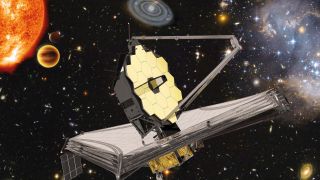James Webb Space Telescope tweaks observing plans to avoid micrometeoroids

After taking a few hits, NASA's newest space telescope will adjust its observation strategy to avoid its mirror being struck by tiny space rocks.
The James Webb Space Telescope (Webb or JWST) has yet to mark its launch anniversary, but over the past months 14 dust-size micrometeoroids have hit its golden mirror, which stretches 21 feet (6.5 meters) across. The observatory's view remains stunning, but mission personnel have decided to adjust the telescope's operations to avoid directly facing what experts have identified as "micrometeoroid avoidance zones."
"Micrometeoroids that strike the mirror head-on have twice the relative velocity and four times the kinetic energy, so avoiding this direction when feasible will help extend the exquisite optical performance for decades," Lee Feinberg, Webb optical telescope element manager at NASA's Goddard Space Flight Center in Maryland, said in a statement.
Gallery: James Webb Space Telescope's 1st photos
JWST planners knew to expect micrometeoroid impacts, and the telescope was designed to withstand the types of strikes scientists anticipated. However, after an impact in late May left more damage than the models predicted, mission personnel began studying ways to reduce impacts.
Webb is unusually vulnerable because its mirror is vast and directly exposed to space — unlike, for example, the Hubble Space Telescope's mirror, which is smaller and shielded by protective casing. But for JWST, shrinking or shielding the mirror would have reduced the telescope's power.
A team of experts gathered to analyze the May impact determined that the event was an unlucky break because a micrometeoroid with unusually high energy happened to strike a more vulnerable area of the mirror. Still, the scientists determined that it was worth tweaking JWST's observations to further reduce the odds of another such strike on the vast light-collecting surface.
Get the Space.com Newsletter
Breaking space news, the latest updates on rocket launches, skywatching events and more!
JWST is orbiting what scientists call a Lagrange point, where gravitational tugs even out to create "parking spots" that spacecraft can exploit to reduce the fuel and maneuvers it needs to stay in position. JWST's particular Lagrange point is located nearly 1 million miles (1.5 million kilometers) away from Earth, on the side of our planet opposite the sun.
Other spacecraft have been stationed here before, which helped scientists model how many tiny micrometeoroids the observatory might encounter, and after the analysis of the May event, experts identified "micrometeoroid avoidance zones" of particular risk along the telescope's path through space.
Beginning next summer, as JWST embarks on its second year of science operations, the telescope will aim to avoid pointing its mirror into these zones during observations. Instead, JWST personnel will schedule those observations for a different time of year, when the micrometeoroid threat in the necessary direction is lower. The tweak won't block any science, although it will make scheduling the observatory more complicated, NASA officials have said.
Time-sensitive observations, including of objects within the solar system, can still occur in avoidance zones.
The announcement comes as the Space Telescope Science Institute in Maryland, which operates JWST, has begun accepting proposals from scientists who want to use the facility during its second year of science work, called Cycle 2.
Email Meghan Bartels at mbartels@space.com or follow her on Twitter @meghanbartels. Follow us on Twitter @Spacedotcom and on Facebook.
Join our Space Forums to keep talking space on the latest missions, night sky and more! And if you have a news tip, correction or comment, let us know at: community@space.com.

Meghan is a senior writer at Space.com and has more than five years' experience as a science journalist based in New York City. She joined Space.com in July 2018, with previous writing published in outlets including Newsweek and Audubon. Meghan earned an MA in science journalism from New York University and a BA in classics from Georgetown University, and in her free time she enjoys reading and visiting museums. Follow her on Twitter at @meghanbartels.